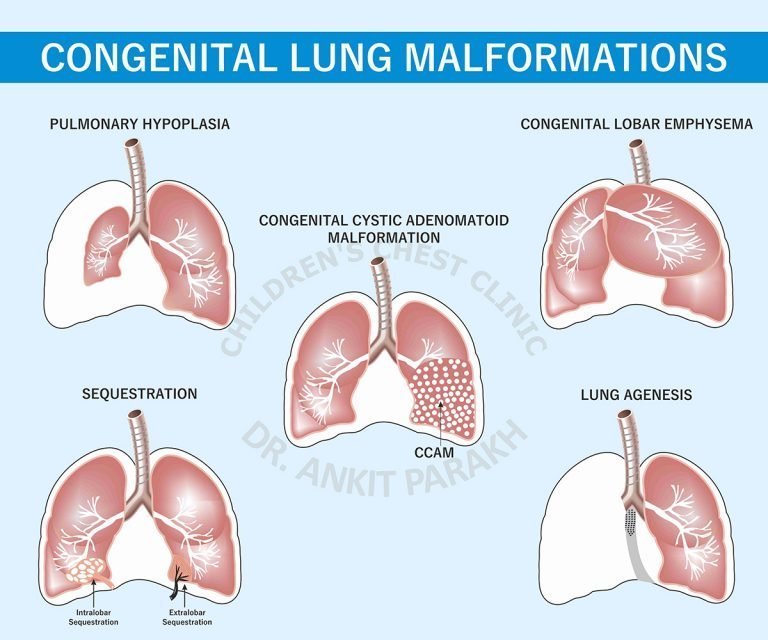
Congenital Lung Malformations
What are Congenital Lung Malformations?
Congenital lung malformations are structural abnormalities of the lungs or airways that develop before birth. They may be detected during routine prenatal ultrasounds or after birth when symptoms arise. Common types of congenital lung malformations include:
- Lobar Emphysema: Overinflation of one or more lobes of the lung, leading to respiratory distress in severe cases.
- Cystic Adenomatoid Malformation (CCAM): A condition where cysts or abnormal growths form in the lungs, potentially impacting lung function.
- Pulmonary Sequestration: A segment of lung tissue that does not connect to the normal airway system and receives its blood supply from an abnormal artery.
- Pulmonary Hypoplasia: a part of a lung is undeveloped or absent. In some cases one lung is absent.
Types of Congenital Lung Malformations
Congenital Lobar Emphysema (CLE)
- CLE involves overexpansion of a lung lobe due to airway obstruction or abnormal cartilage development.
- Symptoms may include respiratory distress, rapid breathing, or cyanosis in newborns.
- Treatment typically involves surgical removal of the affected lobe.
Cystic Adenomatoid Malformation (CCAM)
- CCAM is characterized by cystic or solid masses in the lungs, often detected during prenatal imaging.
- Large lesions can cause breathing difficulties, while smaller ones may remain asymptomatic for years.
- Management may include surgical excision, especially for symptomatic or growing lesions.
Pulmonary Sequestration
- In sequestration, a non-functioning segment of lung tissue lacks normal airway connections and receives blood from the systemic circulation.
- It can lead to recurrent infections or respiratory symptoms.
- Surgical resection is the standard treatment.
Pulmonary Hypoplasia
- Pulmonary hypoplasia refers to the incomplete development of lung tissue, resulting in small, underdeveloped lungs.
- It is often secondary to conditions such as congenital diaphragmatic hernia, oligohydramnios (low amniotic fluid), or skeletal abnormalities.
- Symptoms include severe respiratory distress and hypoxemia in newborns.
- Treatment focuses on respiratory support and managing underlying conditions, though severe cases may have a poor prognosis.
Symptoms of Congenital Lung Malformations
- Difficulty breathing or shortness of breath
- Frequent respiratory infections
- Chest discomfort or persistent cough
- Cyanosis (bluish discoloration of the skin)
- Failure to thrive in severe cases
Diagnosis
Early detection is crucial for managing lung malformations. Diagnostic methods include:
- Prenatal Ultrasound: May identify abnormal lung growth during pregnancy.
- Chest X-rays: To visualize structural abnormalities.
- CT or MRI Scans: Provide detailed images for accurate diagnosis.
- Bronchoscopy: Used to assess airway involvement.
Treatment Options
Treatment depends on the type, size, and severity of the malformation:
- Observation: Asymptomatic and small lesions may be monitored regularly without immediate intervention.
- Surgery: Symptomatic or progressively enlarging malformations are often treated with surgical removal to prevent complications such as infections or breathing difficulties.
- Supportive Care: Oxygen therapy and antibiotics may be used to manage symptoms and infections.
Long-Term Outlook
With timely diagnosis and treatment, most children with congenital lung malformations lead healthy lives. Regular follow-ups with a pediatric pulmonologist are essential to monitor lung function and address any complications.
Frequently Asked Questions (FAQs)
1. What causes congenital lung malformations?
Congenital lung malformations occur due to abnormal lung development during fetal growth. The exact cause is often unknown but may involve genetic or environmental factors.
2. Can congenital lung malformations be detected before birth?
Yes, many malformations are detected during routine prenatal ultrasounds or fetal MRI scans.
3. Is surgery always necessary for congenital lung malformations?
Not always. Small, asymptomatic malformations may only require monitoring, while larger or symptomatic ones often need surgical removal.
4. Can congenital lung malformations cause long-term issues?
Without treatment, complications such as infections, breathing difficulties, or lung damage can arise. However, most children recover well with proper care.
5. What is the role of a pediatric pulmonologist in managing these conditions?
A pediatric pulmonologist specializes in diagnosing and managing respiratory disorders in children. They play a key role in evaluating, treating, and monitoring children with congenital lung malformations.
By understanding congenital lung malformations, parents can work closely with healthcare providers to ensure timely intervention and optimal outcomes for their children.



